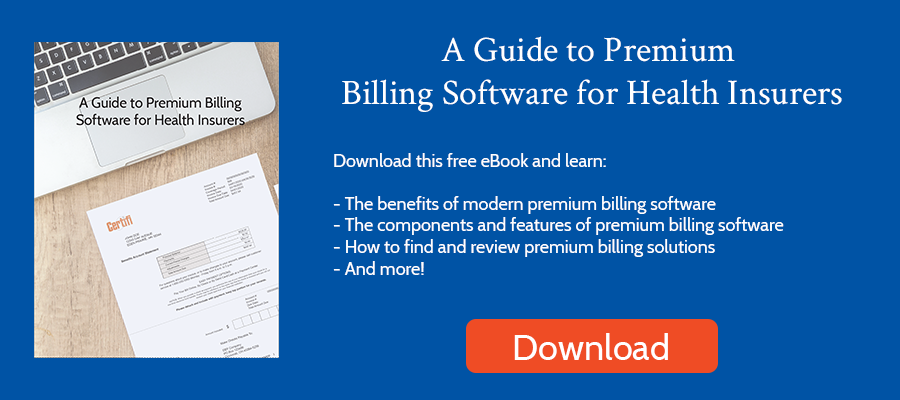“Automated electronic billing applications or business process outsourcing (BPO) and business process as a service (BPaaS) vendors lower transaction costs and raise member satisfaction in commercial segments.”1
– Gartner®, 7 Ways Payer CIOs Can Grow Profits in Medicare Advantage, Managed Medicaid and Individual Exchange Markets, Bryan Cole, December 15, 2021
As the federal healthcare.gov exchange enters its tenth year, the political climate around the Affordable Care Act has settled. The American Rescue Plan Act temporarily introduced new subsidies that increased enrollment. As a result, more health insurers offer plans on the exchange in more counties and states, stabilizing the market.
In most exchanges, health plans are responsible for billing enrollees. Many plan to upgrade their health insurance premium billing solution to improve exchange billing accuracy and efficiency.
If your health plan is one of them, here are five questions health insurers participating in exchanges should ask potential premium billing vendors:
How do you accept binder payments from exchanges and shopping platforms?
Less sophisticated billing systems may struggle to manage binder payments. Typically, insurers prefer members make the binder payment when enrolling in a plan because it’s easier than collecting it later when the enrollment data flows into their system. Failing to collect payment upon enrollment can lead to higher churn and lost revenue.
Some premium billing solutions struggle to pair that payment to a billing account without complete enrollment data.
Ask potential vendors if, how, and when they accept binder payments. At Certifi, other systems can leverage our API to pass us a member identifier and the payment amount. That creates a placeholder record we synchronize with the member demographic data when the enrollment data arrives.
Can your solution store payment rules based on different attributes?
Health insurers participating in exchanges want flexibility when it comes to payments used. Some don’t want to accept credit cards for specific lines of business. Or, they only want to process a credit card for the binder payment. Some may offer a cash payment option for lines of business, like Medicare Advantage, that target seniors or have small premiums that members would prefer to pay in cash.
As a result, look for premium billing solutions that can flexibly offer different payment rules based on population attributes. In Certifi, we use our unique entity hierarchy to group consumers together and then can create business rules specific to those groups. That makes it easy to create different rules for on-exchange, Medicare Advantage, small group, large group, etc.
Can existing payment methods be migrated to your platform?
If you are transitioning to a new premium billing vendor, you want to transfer member payment methods to your new solution. But can you? If you can’t, you could face member payment disruptions as they’ll need to re-register account payment information. It’s a negative customer experience.
Be sure to ask if you can migrate existing member payment methods. Due to the sensitive nature of the account information, migrations must follow PCI requirements. We typically have clients transfer that data directly to a PCI-compliant payment processor. That processor vaults the account information and sends a token to our billing system.
Can you calculate and apply exchange user fees?
The Department of Health and Human Services (HHS) funds the federal health insurance exchange by charging insurers a user fee. That fee has varied throughout the years but was 2.25% of premiums for 2022. State-run health insurance exchanges also may charge a user fee.
Many health insurers pass that fee to consumers. But can your billing solution calculate that user fee, include it in the premium invoice, and remit it to the exchange, especially if you offer health insurance in multiple states with varying user fees?
Certifi can embed the user fees into rate rules and automatically calculate those fees as part of the invoicing process. Upon payment, we can separate that user fee from the payment and remit it to the exchange, sending the remainder of the premium to the carrier.
Can subsidy revenue be tracked and reported separately?
The Inflation Reduction Act temporarily extended the American Rescue Plan Act premium tax credits through the end of 2025. That results in a significant number of individuals that buy health insurance on the exchange being eligible for subsidies.
Health insurers want to be able to report that subsidy revenue separately from other income. To do that, you’ll need to rely on your billing platform.
Certifi can facilitate that subsidy revenue tracking. We typically track subsidies as specific receivables as a portion of the premium. As a result, they can be reported separately from the premium revenue.
1GARTNER is a registered trademark and service mark of Gartner, Inc. and/or its affiliates in the U.S. and internationally and is used herein with permission. All rights reserved
Certifi’s health insurance premium billing and payment solutions help healthcare payers improve member satisfaction while reducing administrative costs.



